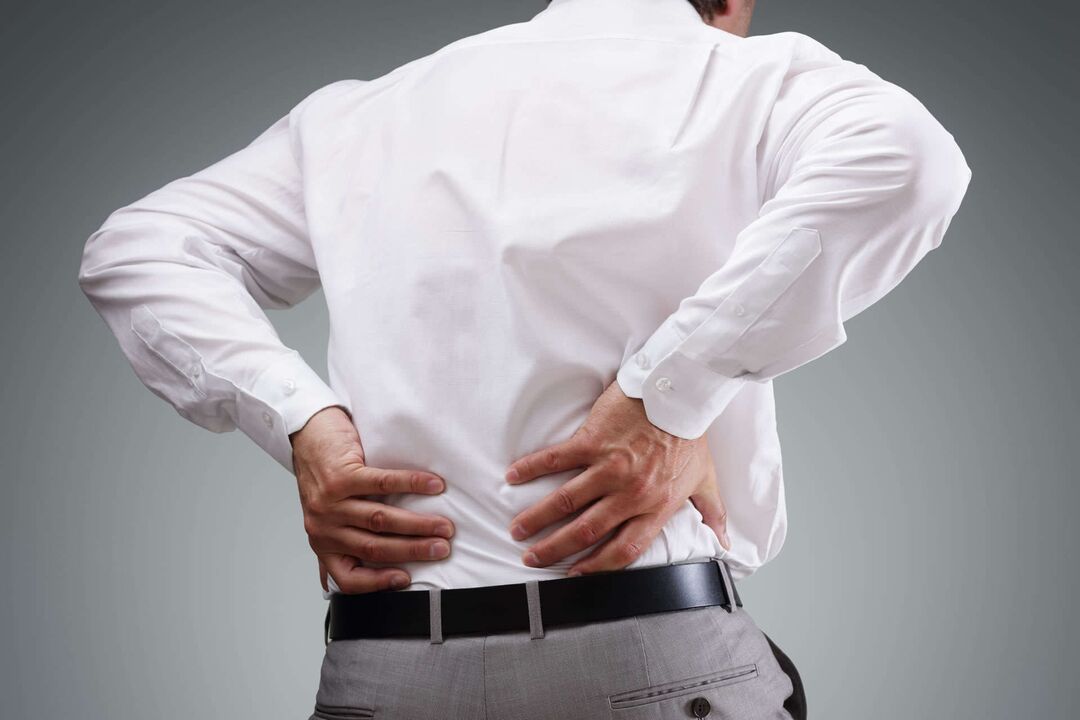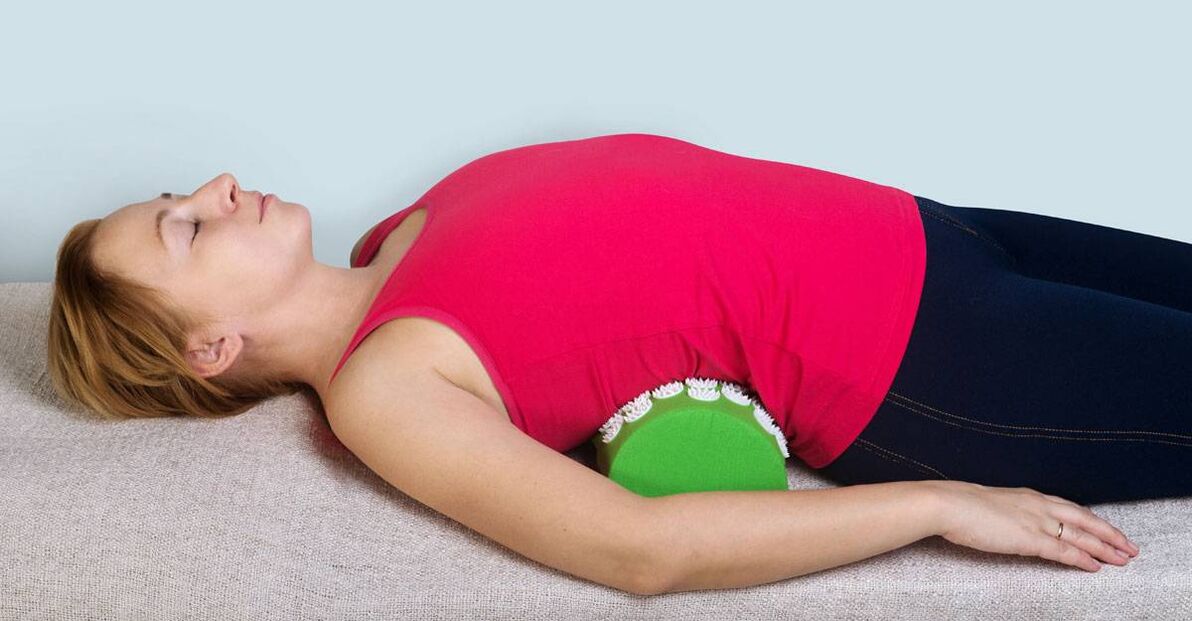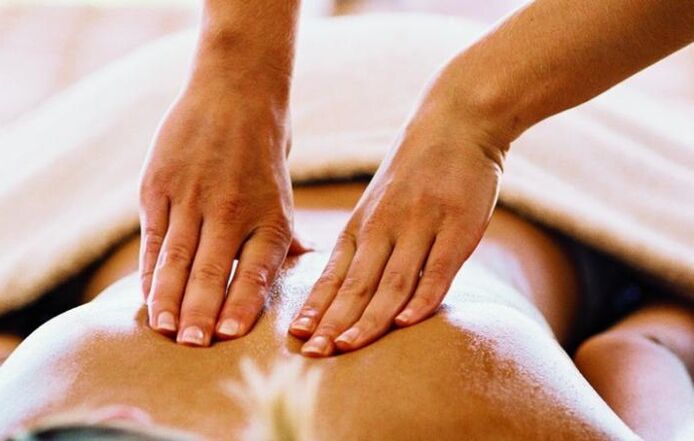Osteochondrosis of the spine destroys the bone and cartilage of one or more parts of the spine. This disease is chronic and occurs in almost every elderly person. This is due to the normal aging of the body.

Intervertebral discs undergo atrophic changes, and this depends on a number of factors at what age:
- injury;
- diseases and spinal overload.
Spinal overload includes:
- walking with bent back;
- incorrect seat;
- spinal cord structure characteristics;
- inadequate nutrition of spinal tissues due to hereditary disorders.
In osteochondrosis, the nucleus between the discs loses some of the water. As a result, metabolic disorders occur in the nucleus and it is difficult for various minerals and vitamins to enter.
After a while, cracks will appear on the disc, it will be flat. Then the nearby joints and ligaments are affected, tissue inflammation develops. Inflammation causes adjacent vertebrae to move. This is accompanied by dangerous radical symptoms: pain along the affected nerve.
The appearance of an intervertebral hernia is also possible, which in turn can cause compression of the spinal cord. Osteochondrosis is characterized by the appearance of osteophytes - bone growth on the vertebral bodies. These increases can compress the spinal cord and cause radical syndrome.
The neck and lumbar regions are most susceptible to osteochondrosis.
Cervical osteochondrosis
Cause:
- sporting activities (weight lifting);
- overweight;
- metabolic disease;
- sedentary work (programmers, accountants, drivers, etc. );
- goosefoot;
- spinal cord injury;
- hypothermia.
Symptoms
The main symptoms of osteochondrosis of the cervical spine are head and neck pain. A person is worried about severe headache, neck pain, arm radiating pain, sternal pain. The patient may complain of lumbago - the appearance of sharp neck pain, muscle cramps and restraint.
In addition, a person may hear a crack as he turns his neck. Trapped nerves and blood vessels can make a person numb their tongue and fingertips. The patient complains of hearing and vision impairment, high blood pressure, and weakness in the muscles of the arms and legs.
Chest osteochondrosis
This type of osteochondrosis is quite rare. This is due to the anatomical structure of the thoracic spine. It consists of 12 vertebrae that connect to the ribs through joints. From the front, the ribs are connected by the sternum. This creates an excellent frame from the spine, sternum and ribs that protects the internal organs from various injuries.
The vertebrae of the thoracic region are low in height, with long thoracic protrusions superimposed on each other like shingles. Due to this structure, this part of the spine has low mobility. The intervertebral discs in the chest region are rarely damaged.
Causes of this type of osteochondrosis:
- irrational load distribution;
- delayed feeding of intervertebral discs;
- sedentary work;
- presence of scoliosis.
Symptoms
Like other types, pain is the leading symptom of chest osteochondrosis.
But in chest osteochondrosis, the pain may be different. Dorsalgia - prolonged discomfort and mild pain along the thoracic vertebrae. The pain can affect the neck and lumbar regions.
Dorsago is a sign of chest osteochondrosis in which the pain takes the form of a seizure. By its nature, it leads to intense, acute, difficulty breathing and restricted muscle movement. In addition to pain, patients may experience chest numbness, sexual dysfunction, and heart, kidney, and stomach pain.
What is the danger of violating the chest region?
The spinal column is designed to narrow in the thoracic region, so that a hernia from osteochondrosis quickly leads to compression of the spinal cord. This can easily lead to heart, pancreas, liver and kidney problems as the chest region is connected to these organs by nerve fibers. That is why it is very important to see a doctor in time. It helps to find out where the signs of osteochondrosis are bothering you and provides competent treatment for the disease.
Lumbar osteochondrosis
Osteochondrosis of the lumbar spine occurs due to weight gain. Normally, there is a nucleus in the center of the intervertebral disc that contains a large amount of water. The liquid makes the core slightly compressible and requires 500 kg of compaction to tear.
However, the disc affected by osteochondrosis will be weaker and only 200 kg will be needed to rupture. If a person weighing 70 kg lifts a load of 15 kg in a bent position, and this is 200 kg for the spine, the disc may rupture. Therefore, the first symptoms of osteochondrosis of the spine occur when lifting weights.
Symptoms
- pain in the lumbar region;
- immobility in the lower back;
- sleep disorders;
- irritability;
- fatigue;
- the impossibility of meeting household needs;
- decreased sexual function in men;
- violation of the menstrual cycle;
- cold foot syndrome.
With the transition of osteochondrosis to the sacral region, the patient causes pain in the kidney area and impairs urination.
Diagnostics
Osteopondrosis is treated by a neurologist. Initially, it examines the spine, drawing attention to the presence of scoliosis. After the sensation, the doctor will be able to understand how it affected the spine, tendons and nerves.
After the neurologist suspects osteochondrosis of the spine, he refers the patient for further examination. This includes passing X-rays, magnetic resonance imaging. If destruction of the intervertebral disc is suspected, discography is performed. They are also required to determine the extent of damage to the nerve pathways.
Osteochondrosis of the spine is usually very difficult to diagnose. After all, a person may complain of heart, liver, kidney, pancreatic, or sexual dysfunction. Nevertheless, after a thorough examination, an experienced doctor will suspect this disease and may prescribe appropriate treatment.
Treatment
Treating osteochondrosis is a very long and difficult process. In the acute period, the patient needs the rest of the affected segment. If the cervical spine is affected, the patient should wear a Shants fastening collar. If the lumbar spine hurts, the patient needs bed rest. It is best if the patient is hospitalized. Only there will you be able to fully comply with the designated regime. The bed of such a patient must be hard. To do this, a wooden plank is placed under the mattress.
Drug treatment
As mentioned above, the main symptom of the disease is pain. Therefore, the patient is prescribed analgesics, non-steroidal anti-inflammatory drugs to relieve pain and other symptoms of osteochondrosis.
Unfortunately, long-term use of these drugs damages the mucous membranes of the gastrointestinal tract, and the patient develops the following symptoms:
- nausea;
- What number;
- abdominal pain;
- feeling of difficulty in the abdomen.
Gastric ulcer may also get worse or stomach bleeding may occur. Therefore, consult your doctor before using these medicines. If the pain caused by osteochondrosis lasts for 3 months, antidepressants are prescribed with these drugs. They have been found to be able to reduce pain in addition to their sedative effects.
All medications can be classified as symptomatic therapy. They help relieve pain but do not rid a person of the disease.
Chondroprotectors are prescribed to repair intervertebral discs and cartilage. These drugs improve connective tissue metabolism and help repair cartilage. The medication is taken for a long time, on average 4-6 months.
In addition to repairing tissues and improving metabolism, these drugs also have an analgesic effect. Another group of drugs needed for osteochondrosis of the spine are drugs that improve blood circulation, their use helps to dilate blood vessels, and when thioctic acid is taken together, the metabolism of nerve cells is improved.
As with any disease, patients need calcium supplements. It restores bone tissue activity, increases the strength of ligaments and tendons, and prevents osteoporosis - a disease associated with osteochondrosis.
Physiotherapy

The applied load on the spine improves the patient's condition. But you have to perform the exercises extremely carefully. In the acute period, physical education is contraindicated. Only when the pain is relieved can you start exercising a little.
Exercise improves blood circulation in the spine and strengthens muscles. Thanks to the blood flow, the metabolism improves and the repair of damaged intervertebral discs begins. But you should also remember that classes should be done regularly, otherwise there will be no results.
Exercises for cervical spine lesions
- Lie on your back and straighten up. Place one hand on your abdomen and the other on your chest and inhale, hold your breath for 10 minutes, then blow it out and relax. The duration of the exercise is 3-5 minutes. You need to do it 3-5 times a day.
- Lie on your stomach and straighten your legs. Leaning on your abdomen and legs, you should lift your head and upper chest. Exercise for 3-5 minutes at 30-second intervals.
- Lie on your back and bend your knees. In this position, turn left and right. Exercise for 3-5 minutes at 30-second intervals.
Exercises for chest region lesions
- Lie on your stomach. Put your hands on the floor and lean back. Hold this position for 5-10 seconds. Do the exercise for 3-5 minutes at 20-second intervals.
- Lie on your back. Raise your head and legs ("boat"). Hold for 10-20 seconds. Do the exercise for 3-5 minutes at 20-second intervals.
Exercises for lumbar spine lesions
- Lie on your back, bend your knees and put it on your chest. Swing back and forth and roll from the back to the sacrum and back. Swing for up to 2 minutes. Then you need to lie down and relax.
- You need to stand on all fours and lean as far as you can. Do the exercise for 3-5 minutes at 20-second intervals.
- While standing, imagine twisting the hoop for 2-3 minutes. Exercise 10 times a day.
Surgery
In the absence of the effect of conservative treatment and in the presence of complications of osteochondrosis, surgical treatment is prescribed. During spinal stabilization, the pressure on the spinal cord and roots is relieved. If a person has an intervertebral injury, it is removed. Because this surgery can damage the spinal cord and nerves, it is only performed for vital reasons.
Physiotherapy treatment
The designation of physiotherapy procedures has a positive effect on the course of the disease and accelerates the healing process. In case of osteochondrosis it is allowed:

- a visit to a sauna or spa;
- swim in the pool;
- massage;
- paraffin therapy;
- manual therapy;
- laser therapy;
- various baths;
- mud therapy;
- electrophoresis with anti-inflammatory drugs or muscle relaxants;
- magnetotherapy;
- darsonval.
All of these procedures improve blood circulation in the diseased area, allowing the muscles to relax and the whole body to relax. Physiotherapy procedures are prescribed during the rehabilitation period when the patient is not disturbed by severe pain.
Prophylaxis
No one is immune to osteochondrosis. After all, we are all aging, and our whole bodies are aging with us. To prevent the disease from ruining your plans, you need to play sports at a young age. Moderate physical activity improves blood circulation, normal metabolism. It also trains the muscles that protect the spine. To prevent osteochondrosis, every person should:
- to eat properly - vitamins and minerals needed by the body;
- refuse bad habits;
- take part in physical education;
- do not bend over;
- protect your back from hypothermia;
- do not lift too heavy objects;
- take a contrast shower and moderate;
- avoid stress.
It is especially important for people with this disease to follow all the recommendations because their failure is exacerbated. If you have a long-lasting back pain, you should seek professional help. Only a doctor can correctly diagnose and prescribe treatment.
Do not delay a visit to the clinic because it is better to treat the disease at an early stage. Also, don’t self-medicate - every medication has its own contraindications that you may not be aware of. Strictly follow all the recommendations of your doctor and then the disease will recur soon!













































